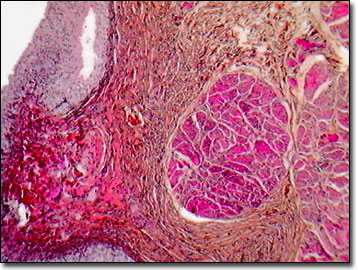Brightfield Digital Image Gallery
Human Bladder
The old barroom adage, "you can't buy beer, you can only rent it", is indelicately tied to the function of the human bladder and the entire urogenital system. Although the average person will drink 8,000 gallons of water during their lifetime, the typical human bladder can hold only 13 ounces of liquid at one time.

The human bladder is a smooth, collapsible muscular sac that stores urine produced by the kidneys. For most, emptying the bladder is a reflex reaction that takes children several years to master. Depending on fluid intake, the average human adult voids the bladder from four to eight times per day. In either the male or female, urine enters the bladder through two tubes, the ureters, each connected to a kidney, and exits the bladder via the urethra, a thin-walled muscular tube.
For control of urination, the urethra utilizes two sphincter muscles. The internal urethral sphincter remains closed when urine is not being passed, preventing leakage and embarrassment. Surrounding the urethra, the external urethral sphincter is controlled voluntarily. Three layers are present in the human bladder: the mucosa, the detrusor, and the trigone. Transitional epithelium is contained within the lining of the mucous membrane or mucosa. These layered cells can slide across one another as the bladder wall thickens or thins while filling and emptying. The intermediate layer, the detrusor, is composed of involuntary muscle, having fibers arranged in three layers, each running in a different direction, and an outer connective tissue layer. As the name implies, the trigone is outlined by the three openings of the two ureters and the urethra.
Stretch receptors inside a normal human bladder detect when the distention of the bladder is sufficient for urinating. These receptors activate a reflex pattern that results in the contraction of the detrusor muscles and the relaxation of the internal urinary sphincter, moving stored urine into the upper part of the urethra. Normally, the external sphincter is voluntarily controlled and kept closed until emptying the bladder is convenient. Eventually, the urge to urinate will become irresistible and urination will occur, with or without voluntary control. When emptied, the bladder assumes a pyramid shape with its walls collapsed into folds known as rugae. While the bladder is essentially a storage and disposal organ, the more complicated kidneys act as blood filters and help balance the body's electrolytes.
Contributing Authors
Cynthia D. Kelly, Thomas J. Fellers and Michael W. Davidson - National High Magnetic Field Laboratory, 1800 East Paul Dirac Dr., The Florida State University, Tallahassee, Florida, 32310.
BACK TO THE BRIGHTFIELD IMAGE GALLERY
BACK TO THE DIGITAL IMAGE GALLERIES
Questions or comments? Send us an email.
© 1995-2025 by Michael W. Davidson and The Florida State University. All Rights Reserved. No images, graphics, software, scripts, or applets may be reproduced or used in any manner without permission from the copyright holders. Use of this website means you agree to all of the Legal Terms and Conditions set forth by the owners.
This website is maintained by our
Graphics & Web Programming Team
in collaboration with Optical Microscopy at the
National High Magnetic Field Laboratory.
Last Modification Friday, Nov 13, 2015 at 01:19 PM
Access Count Since September 17, 2002: 20928
Visit the website of our partner in introductory microscopy education:
|
|
